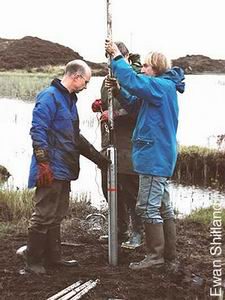Discovering and understanding
Midges and climate change
Global warming
Scientists agree that our climate is warming. But it is difficult to predict exactly how the climate will change in the future.

Scientists need to test their climate change models by testing them against how climate has changed in the past. So, to test these models we need a way of understanding past climate change.
'A colleague told me that there were plenty of midges preserved in lake sediments but that no-one knew how to identify them or what to do with them.' Steve Brooks, Entomologist
Steve followed up this idea, and discovered a way to track historical climate changes by studying midges.
Tracking climate change
Larvae of non-biting midges live in fresh water. When they die, they fall to the bottom of the lake and become part of its sediment.

Samples of this sediment can be brought up to the surface and analysed. The mud can be radio-carbon dated, and Steve can identify the different species of dead midge using a microscope and comparing them to species in our collections.
Each different species of midge thrives at a particular temperature. So, the number and type of midge can indicate what the temperature was at that point in history.